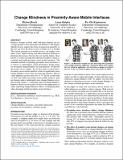Files in this item
Change blindness in proximity-aware mobile interfaces
Item metadata
| dc.contributor.author | Brock, Michael Oliver | |
| dc.contributor.author | Quigley, Aaron John | |
| dc.contributor.author | Kristensson, Per Ola | |
| dc.date.accessioned | 2018-04-21T23:33:44Z | |
| dc.date.available | 2018-04-21T23:33:44Z | |
| dc.date.issued | 2018-04-21 | |
| dc.identifier | 252003723 | |
| dc.identifier | 0dabd6e5-a707-40d3-9bf8-9c9474145972 | |
| dc.identifier | 85046973301 | |
| dc.identifier | 000509673100043 | |
| dc.identifier.citation | Brock , M O , Quigley , A J & Kristensson , P O 2018 , Change blindness in proximity-aware mobile interfaces . in Proceedings of the 2018 CHI Conference on Human Factors in Computing Systems (CHI'18) . , 43 , ACM , New York, NY , ACM CHI 2018 Conference on Human Factors in Computing Systems , Montréal , Canada , 21/04/18 . https://doi.org/10.1145/3173574.3173617 | en |
| dc.identifier.citation | conference | en |
| dc.identifier.isbn | 9781450356206 | |
| dc.identifier.other | ORCID: /0000-0002-5274-6889/work/43873410 | |
| dc.identifier.uri | https://hdl.handle.net/10023/13179 | |
| dc.description | Funding: Google Faculty award and EPSRC grants EP/N010558/1 and EP/N014278/1 (P.O.K.). | en |
| dc.description.abstract | Interface designs on both small and large displays can encourage people to alter their physical distance to the display. Mobile devices support this form of interaction naturally, as the user can move the device closer or further away as needed. The current generation of mobile devices can employ computer vision, depth sensing and other inference methods to determine the distance between the user and the display. Once known, a system can adapt the rendering of display content accordingly and enable proximity-aware mobile interfaces.The dominant method of exploiting proximity-aware interfaces is to remove or superimpose visual information. In this paper, we investigate change blindness in such interfaces. We present the results of two studies. In our first study we show that a proximity-aware mobile interface results in significantly more change blindness errors than a non-moving interface. The absolute difference in error rates was 13.7%. In our second study we show that within a proximity-aware mobile interface, gradual changes induce significantly more change blindness errors than instant changes confirming expected change blindness behavior. Based on our results we discuss the implications of either exploiting change blindness effects or mitigating them when designing mobile proximity-aware interfaces. | |
| dc.format.extent | 7 | |
| dc.format.extent | 3958410 | |
| dc.language.iso | eng | |
| dc.publisher | ACM | |
| dc.relation.ispartof | Proceedings of the 2018 CHI Conference on Human Factors in Computing Systems (CHI'18) | en |
| dc.rights | © 2018, the Owner/Author(s). This work has been made available online in accordance with the publisher’s policies. This is the author created, accepted version manuscript following peer review and may differ slightly from the final published version. The final published version of this work is available at http://dx.doi.org/10.475/123_4 | en |
| dc.subject | Change blindness | en |
| dc.subject | Proxemics | en |
| dc.subject | Proximity interaction | en |
| dc.subject | Proximity awareness interfaces | en |
| dc.subject | Interface design | en |
| dc.subject | BF Psychology | en |
| dc.subject | QA75 Electronic computers. Computer science | en |
| dc.subject | NDAS | en |
| dc.subject.lcc | BF | en |
| dc.subject.lcc | QA75 | en |
| dc.title | Change blindness in proximity-aware mobile interfaces | en |
| dc.type | Conference item | en |
| dc.contributor.institution | University of St Andrews.School of Computer Science | en |
| dc.identifier.doi | 10.1145/3173574.3173617 | |
| dc.date.embargoedUntil | 2018-04-21 |
This item appears in the following Collection(s)
Items in the St Andrews Research Repository are protected by copyright, with all rights reserved, unless otherwise indicated.

